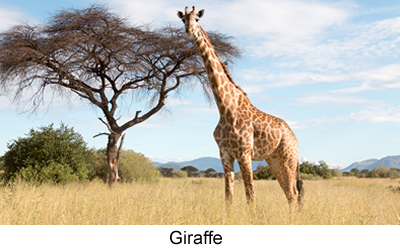 |
|
Name:
Giraffe Classification:
Class: Mammalia
Order: Artiodactyla
Family: Giraffidae
Genus: Giraffa
Species: G.
camelopardalis
Number of Species:
9 recognized subspecies, one
study suggests four distinct species. Characteristics:Very
tall, stilt-like legs with hooves, long neck, two small horns on head,
snout, eyes and large ears on side of head, extremely tough tongue. Status: Vulnerable. How does one eat leaves from the tallest of savannah trees? With a long neck, of course! And only the giraffe can boast having the six-foot long neck needed to reach the branches that other herbivores can't. The giraffe can be found in savannahs throughout sub-Saharan Africa. For many years it was believed that there is only one species of giraffe, Giraffa camelopardalis. Which is divided into nine subspecies. However, in 2016 a team of scientists analyzed the DNA of giraffes from across Africa and decided that there are four separate species: the southern giraffe, northern giraffe, and Masai giraffe. In 2017, another team of scientists reviewed the study and published their own paper, arguing that some of the data may be flawed. So just how many species of giraffe are there? Currently the IUCN recognizes the single giraffe and its nine subspecies. Perhaps further research will settle the dispute. Giraffes are social creatures, living in groups of up to twenty individuals. A herd of giraffes is called a tower, and each tower is different. Some are made up of a single gender, a mix of males and females, or adults with juveniles. These remarkable creatures love to snack on acacia and mimosa trees. Their height lets them reach eighteen feet for males or fourteen feet for females, but it is their thick 21-inch tongues that allow them to eat whole thorny branches! During the mating season, males will compete for females by "necking" each other with their horns. After mating a female will carry her young for fourteen months. The baby will be able to run with its mother ten hours after birth. A baby will stay with its mother for a month or for a year; each individual is different. Giraffes are experts at avoiding predators. Their height helps them scan the area for possible threats. Their eyes are on the sides of their heads, which lets them see in almost any direction they want. Lastly, giraffes have the unique ability to live on only half an hour of sleep! They will steal two minute-power naps here and there throughout the day inbetween eating. This gives predators even less opportunities to sneak up on them! A giraffe is most vulnerable when it bends down to drink water, as it has to spread its legs in an awkward position. Fortunately they can go for days without drinking water as they get most of their moisture from their leafy diet. Giraffes are currently classed as vulnerable, meaning they are at risk of becoming endangered. They face many threats, including poaching, habitat destruction, war/civil unrest, and disease from livestock. They are often hunted for trophies, but their body parts are also used for ceremonial purposes or for traditional medicines that have zero scientific validity. Their numbers have dropped to less than eighty thousand in the wild, and most of the subspecies are endangered or critically endangered. Fortunately a growing number of people are fighting to save this unique animal. The Giraffe Conservation Foundation and the Giraffe Conservation Alliance are two organizations working with locals in Africa to research educate and preserve the giraffe. Several zoos have also teamed up with other organizations and African residents to spread awareness and perform critical research. It is through cooperation and understanding that we can save threatened species like the wonderful giraffe. To learn more about the towers of Africa and how you can help protect them, check out these awesome websites: Giraffe Conservation Foundation-Dedicated
to protecting giraffes and their habitat on national and international
levels Giraffe Conservation Alliance-Working
in multiple African countries with local communities to protect different
giraffe populations and their habitat. ThoughtCo: "10 Fun
Facts About Giraffes"-This fun article has tons of fun information
about giraffes! |
|
|
|
|
||
|
Contact
Us
|
||||
|
Taproot
Guru © ALL RIGHTS RESERVED
|
||||